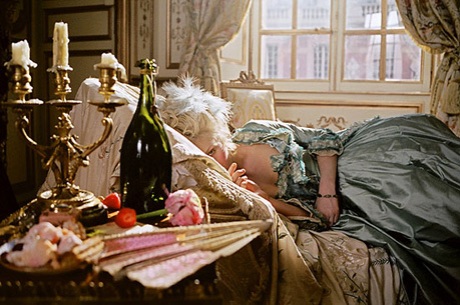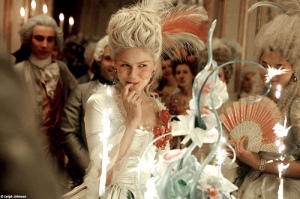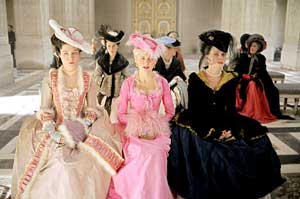process folder
May 13, 2008
Final Portfolio
May 13, 2008
teacher’s draft movie review; Marie Antionette
May 7, 2008
“Watching Marie Antoinette is like watching pre-revolutionary France through the rose-colored glasses of the teen queen visualized by writer-director Sofia Coppola.” Says critique for Splash Magazine Worldwide; Claudia Aguirre. She has taken the historical tale of France’s famous teen-queen, and turned her in to a Paris Hilton figure. Marie Antoinette is a youthful girl growing up against her will within the walls of a palace. Just like a scene from Mean Girls, the film portrays Marie Antoinette, played by Kirsten Dunst, as the new girl in town facing social pressures like gossip, girlish rivalries, and a silly boy. Despite the lack of historical emphasis, the film skillfully represents the life of a young girl brought to a beautiful kingdom destined to be the future queen of France. The limitless credit, the shopping addiction, the partying, the reckless gambling and other qualities that you would read about in a modern day tabloid are all displayed in this colorful film.

Imagery and aesthetics are the key elements of Sophia Coppola films. The setting alone is a major character that evolves just as any other character would in a film, play or novel. An attractive cast (Kirstin Dunst and Jason Schwartzman amongst others) and a luxurious backdrop makes for a very pleasing aesthetic experience. The costumes also add a modern flare to the pre-revolutionary French fashion by adding graphic stripes and floral prints onto traditional costumes as noted in an old issue of Teen Vogue Magazine. Along with the musical score, the colors are guided by the mood of each scene. At first, the scenes are exuberant and childish, with light colored, pastel costumes and just plain shots of the hundreds of rooms in the palace. This parallels the mind and innocence behind a fourteen year old Marie as she comes into the corrupt and sophisticated world of Versailles. Sophia Coppola, the director, was actually given the most access to Versailles than any other filmmaker to date. She uses each room, the different architectural structures and different personal styles to show the transition from childhood to womanhood.

The best part of the film I would have to say would be the aesthetics. The visuals draw you in to the film. Dresses, pastries, champagne, shoes and larger than life wigs are the center of attention in each scene whether it is during a card games, one of the wild parties, or even at a Catholic mass. The movie transitions through music as well as visuals. In the film, after Marie reaches motherhood, the story turns to life in the country. Heavenly, peaceful scenes develop or enhance the nurturing mother and woman Marie has become, even though this is also a point in the movie where her adulterous nature is exposed. Just as the colors and music change in the motherly stage of her life, the ending reflects a somber mood with darkly lit rooms and gloomy music. All of the changes reflect the different mood she was in. The music literally stops with the decline of the monarchy. Basically, the music is the glue that holds the story together while the actors (even the main characters) are but supporting actors. The sounds take the audience along for the ride.

Being stripped of any and everything Austrian, including her puppy, a young Marie is forced into womanhood by marrying the teenage dauphin Louis XVI played by Jason Schwartzman. Her woes begin at the wedding bed; she feels pressured because it is up to her to keep the two countries united by producing an heir to the throne. That on top of the social pressures of court keeps Kirstin Dunst’s character under constant anxiety and fret. To compensate for these troubles, Marie turns to every girl’s sweet escape; shopping and nightlife.

The mixture of ribbons, wigs, dresses, shoes and desserts is visual eye candy. According to other movie critics and bloggers who have critiqued this movie, many who have seen this movie have criticized this as a selfish attempt to sympathize with a stupid girl only interested in herself, but I think Coppola creates a very real and likeable character. The abundant excessiveness and overspending seems like a common reaction of a girl so young thrown into a world like the one she was thrown in. Take today’s heiress for example; she is not yet in charge her inherited empire, so she spends her days shopping, playing with her puppy, partying and boozing. Not that any girl with money out the ass would not do the exact same thing. That is why this film is so enjoyable, it is like being in a fantasy world and you feel like the pretty princess. It is made very apparent that the director wanted the film to be like this because the film rarely deals with any substantial issues such as war, poverty, famine and anything historically important for that matter, at all until the very end of the movie. It never directly affects Antoinette’s life, so we never really see the “dark side of her world.” Her husband and her grandfather king are the only ones who deal with issues if they are brought up. The drama and the cliquish nature that you see with the young royals are both amusing and historically accurate; a much more accurate example of daily life in Versailles than any other theatrical film.
The lack of intellectual and political material in the film is drowned out by the wonderful nineteen eighties rock inspired soundtrack. The music complements and embellishes the personalities of the young characters. The music not only appeals to a younger crowed but it makes the characters appear more life like and human. Brian Reitzell, the music coordinator with whom Sophia Copolla worked with in A Knights Tale, Lost in Translation and The Virgin Suicides, brings a fresh vibe to the film through sound. He uses modern and eighties classics blended with classic 18th century sounds to keep the film flowing perfectly with the emotional idea of the story and makes the characters more appealing and real life-like.

Overall, this movie is another classic Sophia Copolla film, after watching it you know you haven’t gained anything; no moral lessons, no life changing experience not even any tears. But, do you really need that every time you watch a motion picture? Maybe you do maybe you don’t, but this colorful film was a worth while movie that gives you a feeling of stillness and triggers every calming button in your body. From the beauty of the picture to the music, Sophia Copolla scored with this film, the simplicity of the film makes it a winner.

